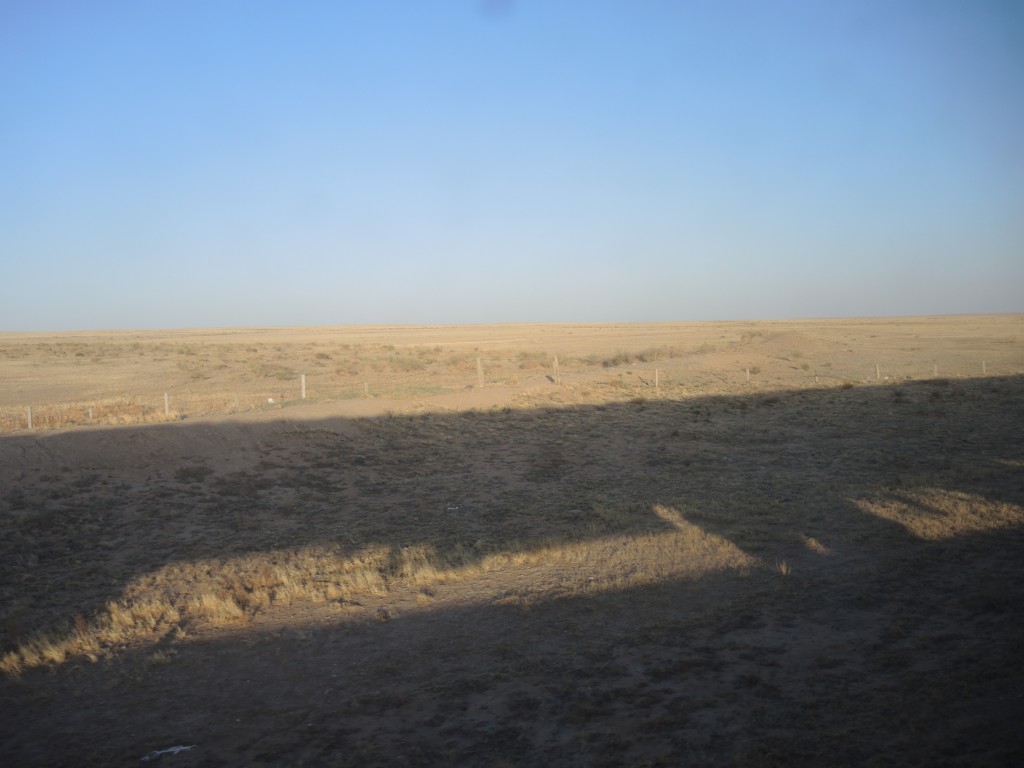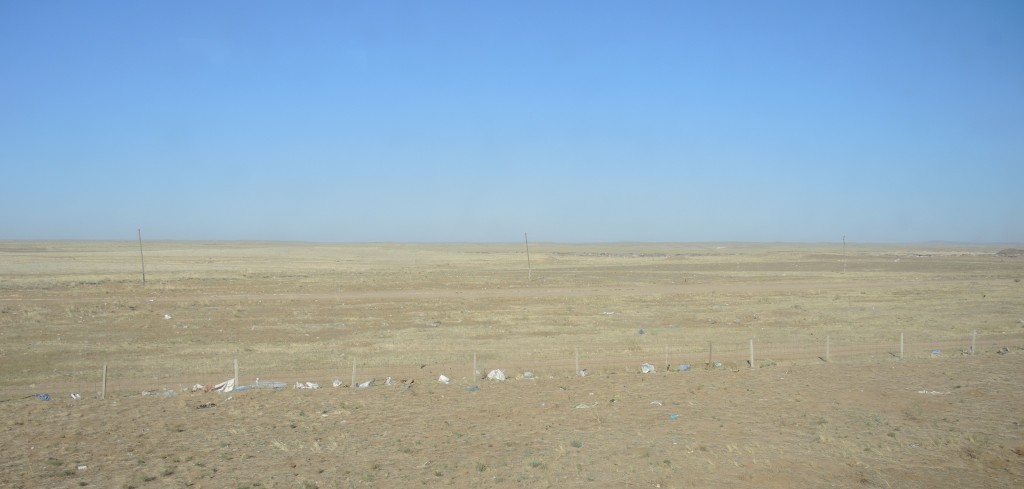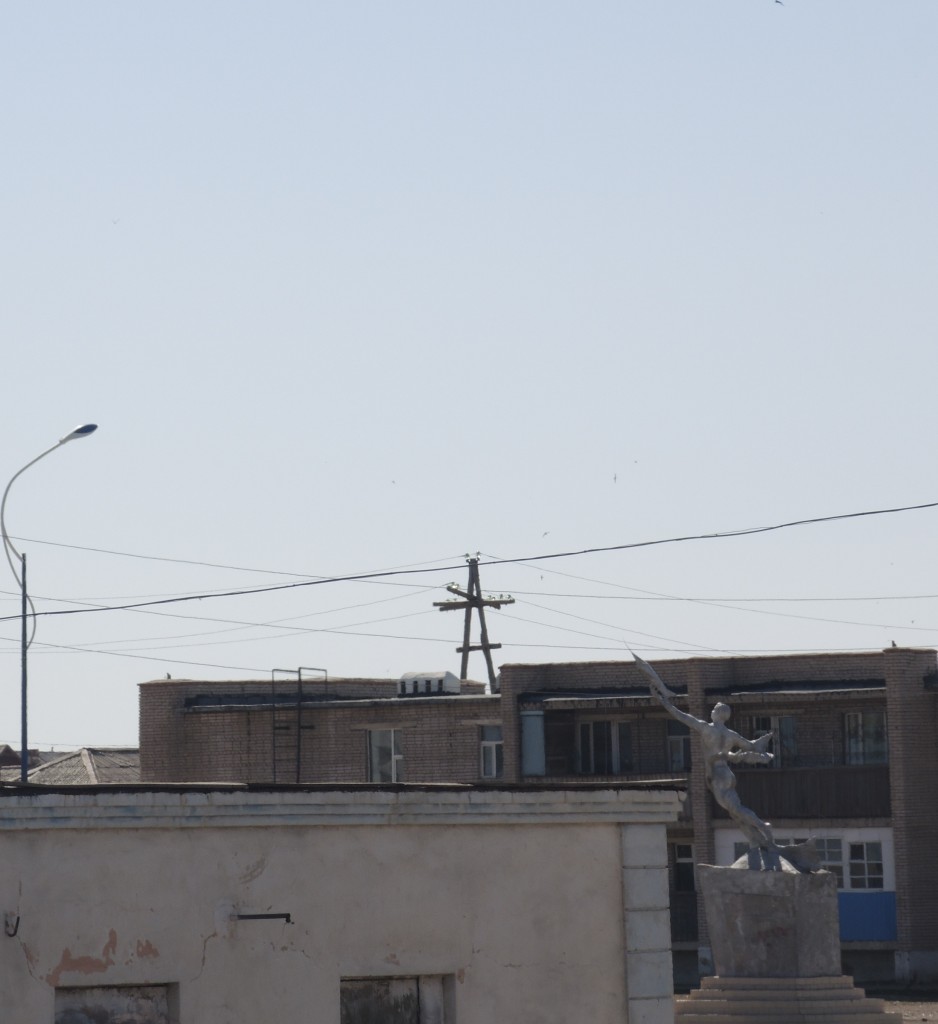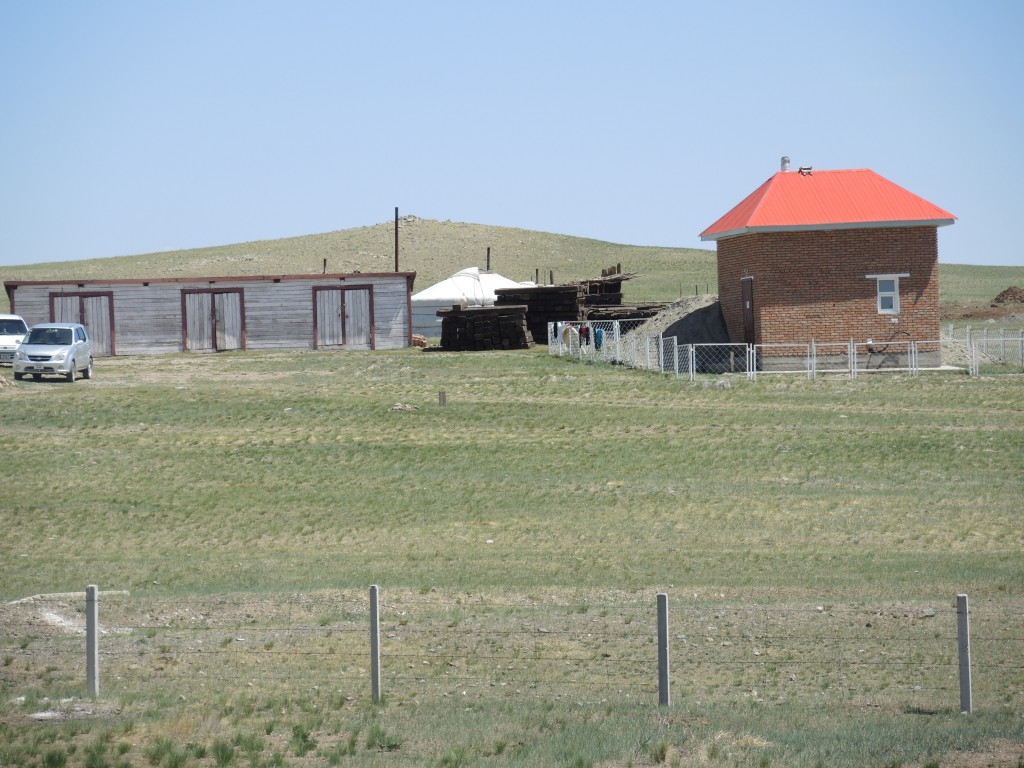6 June.
By 06:30 or so I’d had enough sleep and, apparently so had my cabin mates John, Anne, and Groud. This meant I was able to fish out my camera from my bag without disturbing anyone
and snap a few early morning landscapes.
We still have about seven hours until the train reaches Ulaanbaatar so I expect the day will be a quiet one. My singularly unoriginal first impression of Mongolia is of a vast, somewhat barren, sparsely populated land. Of course, I awoke in the Gobi. If I woke up on a train rumbling through the Mojave, I’d probably have a similar impression of the U S.
I was looking out the wrong side of the train so I missed the first two ger camps that we passed in daylight and that were close enough to be seen from the train. Americans are probably more familiar with the word yurt when discussing the traditional Mongolian nomadic home but yurt is a Russian word and the people in Mongolia seem to prefer ger so that will be my term of choice as well. I’ve spotted a few solitary gers (which is the more typical sight) but I’ve also seen also a few small camps in the distance that were simply too distant to show up as more than dots in a photo.
We’re also seeing grazing goats, camels, and horses but photos are difficult because the train is chugging apace, the windows a bit grimy (and one has to rotate with the other passengers through the open ones so everyone has the chance for some clear pictures), and my camera has an automatic shut off if it sits idle for a short time. This is, in fact, my main obstacle because too often I spot something of interest but find that it has passed before I’ve been able to even turn the camera on let alone get in in frame and in focus.
A thin wire fence isolates the train tracks from the fields beyond. I assume its purpose is to discourage the freely wandering animals from straying onto the tracks. I note this because I’m surprised by the volume of trash – largely plastic – that’s entangled in the fence. 
I’m not looking at heaps of garbage but, unless they serve some other hidden purpose, given the vastness of that landscape and the substantial distances between obvious signs of human activity, I found their quantity surprising. Upon reflection, I realized they might serve as markers to alert the animals of the fence’s presence.
As the train continued its journey to Ulaanbaatar (UB) and beyond, the landscape gradually took on a sense of China in reverse transitioning from desert to grassy plains to occasional stands of trees. The sky seemed exceptionally blue though that may be in part a residual effect of having spent several days in the Beijing smog and rain.
As we passed through the station in Choir (pronounced tshuh-eer), I was only able to get this photo of the monument to Jugderdmidiin Gurragchaa – Mongolia’s first cosmonaut.
One might expect such a tribute to be in UB rather than in front of a small rather out of the way train station. But, as I would learn Mongolians seem disposed to putting monuments and memorials in seemingly odd places. One other observation that has felt particularly true as we’ve passed small towns in Mongolia is that I can’t help but be struck by the universal urge to use colors to enrich the environment, to create art in the everyday and functional, and to find unique forms and manners of expression. This activity is not the province of the elite alone.
I noted early on that traveling by train provides time for reflection and the opportunity to reach uninformed conclusions about the country through which you’re traveling. And as I watched the countryside roll past I did just that. My impression is that Mongolia is a country very much in a state of transition both nationally and individually. Groud told us that over half the population now lives in UB yet many still follow the traditional nomadic life. Visually, there seems to be a certain tension between past and present as evidenced by the number of permanent dwellings one sees that have a ger on the property as well.
Yesterday, I wrote about lunch with Stefane. Today for most of the last hour of the trip I chatted with Iulian and his new wife Eva. Iulian is Romanian and quite a polyglot (I think I counted 7 languages in which he is fluent) and Eva is Norwegian. They’d spent the last year in Beijing and were recently married. They showed me a wedding picture taken on the Mutianyu section of the Great Wall. Incomprehensibly they were taking the train straight through to Moscow – a trip of nearly six days – whence she would continue home to Norway and he to Romania before reuniting a week or so after that and uniting their respective families for their wedding party.
Our conversation was wide ranging and flowed easily between topics ranging from politics, to family histories, to linguistics, and to aesthetics. We covered nothing in depth but it was an interesting hour nevertheless. Iulian thought my family name could have Romanian roots. The Romanian word for Christmas (Crăciun) is pronounced very much like my paternal family name which transliterates as Khryuchawnsky. I was skeptical that a Jewish family in a shtetl in Ukraine somehow adopted and adapted the surname “Christmas” but I let it go in the interest of international relations and because you never know. As promised, you can use this link to see all the pictures from the train from the time we left Beijing until we neared Ulaanbataar.
Note: In keeping with my 2022-2023 reformation of the blog into shorter entries, backdated to maintain their sequence, any comments on this post might pertain to its new configuration. See the full explanation in the post Conventions and Conversions.
Todd
How on earth did you have the stamina for all of this? Miracle man?
Life in Malta proceeds at its usual, enjoyable pace. I have sent you a couple of photographs of the roof terrace on normal email.
Have you come out of hospital yet?
John and Sally
It was not I but my father who was in hospital and he is currently in a rehabilitation facility. Thanks for asking. As for my stamina, my mantra was if the 75 year old Kiwi can do it, then surely I must!
Regards to you both.
I find the pictures fascinating. First of all, the ornate carvings in the dining car are fabulous. Then, the ornate, older buildings are juxtaposed with some very modern architecture. What a study in contrasts. Really did not look anything like what I would have imagined. All quite interesting. Relieved to see there were no pictures of Subway restaurants, etc. but how in the world did a Mongolian BBQ place from Bethesda turn up in Mongolia?? Which one is the original?
PS – the little girl is adorable.
She was adorable in the restaurant, too. And if Wikipedia is to be believed the BD’s is headquartered in Michigan and the one in UB was the first American franchised restaurant in Mongolia established there in 2005. BD’s started as a chain in the U.S. midwest in 1992.
Pretty nice post. I just stumbled upon your weblog and wanted to say that I have truly enjoyed surfing around your blog posts.
“In Which We Reach Ulaanbataar | From Todd’s Mind” was in fact a remarkable post. If perhaps it possessed more pix this would be even a lot better. Take care -Reagan